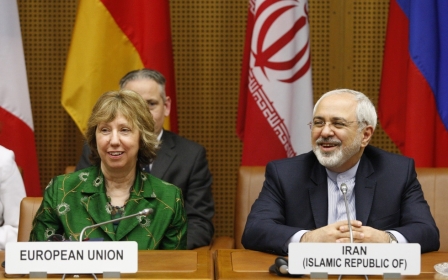Iran official: most of Iran-IAEA agreement implemented

A delegation from the International Atomic Energy Agency has arrived in Iran to visit two nuclear sites ahead of the next round of political talks with world powers next week.
After meeting officials from the Atomic Energy Organisation of Iran on Monday, the IAEA team will travel to Saghand uranium mine and the Ardakan yellow-cake production site, the official Islamic Republic News Agency said. The facilities are located close together, about 450 kilometres (280 miles) from Tehran.
The trip is in line with a seven-step plan agreed between Iran and the IAEA in February to increase transparency over Tehran's nuclear activities.
Behrouz Kamalvandi, Iran's atomic agency spokesman, told Iranian news outlets that "most of the seven-step procedural agreement between Iran and the IAEA has been implemented."
IRNA also reported Sunday that Iran has provided the UN nuclear watchdog with information about detonators with possible military applications called Exploding Bridge Wire (EBW) detonators. Such fast, high-precision detonators could be used in civilian applications, but are mostly known for triggering a nuclear chain reaction. The IAEA believes they form "an integral part of a programme to develop an implosion type nuclear device."
In a 2011 report, the IAEA said that Iran had told the agency that it had developed EBW detonators for civil and conventional military use. But, "Iran has not explained ... its own need or application for such detonators," the IAEA report said.
Disclosure of information about the EBWs is one of seven measures Iran agreed with the IAEA in February to implement this month.
IAEA deputy director general Massimo Aparo is leading the delegation. The meeting on Monday is to discuss the Arak heavy water reactor, an Iranian official told IRNA.
The seven-step agreement is due to be completed by 15 May, two days after the start of political talks in Vienna between Iran and the P5+1 - Britain, China, France, Russia and the United States, plus Germany - aimed at reaching a lasting accord.
IAEA officials previously visited the Lashkar Ab'ad Laser Centre, which is said to have been used for uranium enrichment.
Aparo's delegation is due to leave Iran on Tuesday night, IRNA reported.
Western officials told Reuters it is imperative for Iran to address IAEA concerns about what it calls possible military dimensions to the country's nuclear program, as part of efforts to end a decade-old dispute that has raised fears of a new Middle East war.
They said information about detonators would be welcome, but that Iran must do more in coming months to clear up fears about suspected atomic bomb research. The two sides are expected to agree on new measures to be implemented after 15 May.
"Key will be the next round of (possible military dimensions) topics agreed for discussion," one diplomat in Vienna said.
Middle East Eye propose une couverture et une analyse indépendantes et incomparables du Moyen-Orient, de l’Afrique du Nord et d’autres régions du monde. Pour en savoir plus sur la reprise de ce contenu et les frais qui s’appliquent, veuillez remplir ce formulaire [en anglais]. Pour en savoir plus sur MEE, cliquez ici [en anglais].



